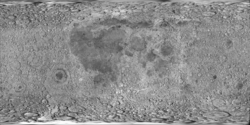Abenezra
| Abenezra Cráter lunar | ||
|---|---|---|
 Imagen de la misión Lunar Orbiter 4 de Abenezra (arriba izquierda) y Azophi (abajo derecha) | ||
| Coordenadas | 20°59′S 11°53′E / -20.99, 11.89 | |
| Diámetro | 42 km | |
| Profundidad | 3.7 km | |
| Colongitud | 349° al amanecer | |
| Epónimo | Abraham ben Meir ibn Ezra | |
|
Localización sobre el mapa lunar | ||
Abenezra es un cráter de impacto ubicado en las escarpadas tierras altas de la sección sur central de la Luna. Está adosado al borde sureste del cráter Azophi. Al noreste se encuentra el cráter Geber, y más hacia el sureste se halla Sacrobosco, más grande.
 |
El borde de Abenezra tiene una forma notablemente poligonal, con segmentos de pared desiguales. Las paredes internas aparecen aterrazadas, y el suelo es irregular y estriado. Una serie de crestas forman patrones inusuales y sinuosos sobre el fondo del cráter. Abenezra se superpone a la parte oriental de otra formación similar, el cráter satélite designado como Abenezra C.
Denominación
[editar]Abenezra debe su nombre al sabio sefardí judío, poeta, comentarista bíblico, astrónomo y astrólogo Abraham ben Meir ibn Ezra. El nombre le fue asignado por Giovanni Riccioli, cuyo sistema de nomenclatura de 1651 se ha estandarizado.[1][2] Los primeros cartógrafos lunares le habían dado diferentes nombres. Así, en el mapa de 1645 de Michael van Langren se denomina "Schyrlei" en homenaje a Anton Maria Schyrleus de Rheita.[1] En este mapa estaba ligeramente separado del otro cráter, al que llamó "Mersenni" (actualmente Azophi).[3] El cráter Rheita, ubicado cerca de Metius, también fue bautizado por Riccioli y posteriormente sería también conocido como cráter del sudeste, dando nombre al Vallis Rheita. El mapa de 1647 de Johannes Hevelius lo agrupó con Azophi y Geber y lo llamó "Antitaurus" en referencia a las montañas de Aladağlar del mundo antiguo.[1][4]
|
Localización de Abenezra
|
 |
Cráteres satélite
[editar]Por convención estos elementos son identificados en los mapas lunares poniendo la letra en el lado del punto medio del cráter que está más cercano a Abenezra.
 |
|
Véase también
[editar]Referencias
[editar]- ↑ a b c Ewen A. Whitaker, Mapping and Naming the Moon (Cambridge University Press, 1999).
- ↑ Riccioli map of the Moon (1651)
- ↑ Langrenus map of the Moon (1645)
- ↑ Hevelius map of the Moon (1647)
- (WGPSN), IAU Working Group for Planetary System Nomenclature (13 de febrero de 2013). «Gazetteer of Planetary Nomenclature. 1:1 Million-Scale Maps of the Moon» (en inglés). UAI / USGS. Consultado el 6 de abril de 2016.
- Andersson, L. E.; Whitaker, E. A., (1982). NASA Catalogue of Lunar Nomenclature (en inglés). NASA RP-1097.
- Blue, Jennifer (25 de julio de 2007). «Gazetteer of Planetary Nomenclature» (en inglés). USGS. Consultado el 2 de enero de 2012.
- Bussey, B.; Spudis, P. (2004). The Clementine Atlas of the Moon (en inglés). Nueva York: Cambridge University Press. ISBN 0-521-81528-2.
- Cocks, Elijah E.; Cocks, Josiah C. (1995). Who's Who on the Moon: A Biographical Dictionary of Lunar Nomenclature (en inglés). Tudor Publishers. ISBN 0-936389-27-3.
- McDowell, Jonathan (15 de julio de 2007). «Lunar Nomenclature» (en inglés). Jonathan's Space Report. Consultado el 2 de enero de 2012.
- Menzel, D. H.; Minnaert, M.; Levin, B.; Dollfus, A.; Bell, B. (1971). «Report on Lunar Nomenclature by The Working Group of Commission 17 of the IAU». Space Science Reviews (en inglés) 12: 136.
- Moore, Patrick (2001). On the Moon (en inglés). Sterling Publishing Co. ISBN 0-304-35469-4.
- Price, Fred W. (1988). The Moon Observer's Handbook (en inglés). Cambridge University Press. ISBN 0521335000.
- Rükl, Antonín (1990). Atlas of the Moon (en inglés). Kalmbach Books. ISBN 0-913135-17-8.
- Webb, Rev. T. W. (1962). Celestial Objects for Common Telescopes, 6ª edición revisada (en inglés). Dover. ISBN 0-486-20917-2.
- Whitaker, Ewen A. (2003). Mapping and Naming the Moon (en inglés). Cambridge University Press. 978-0-521-54414-6.
- Wlasuk, Peter T. (2000). Observing the Moon (en inglés). Springer. ISBN 1-85233-193-3.
- «Lunar Impact Crater Database» (en inglés). Lunar and Planetary Institute (USRA). Consultado el 12 de septiembre de 2017.
Enlaces externos
[editar]- Referencia UAI del CRÁTER
- LPI Digital Lunar Orbiter Photographic Atlas of the Moon
- Mapa LROC
- The-moon.wikispaces.com: Abenezra
 Wikimedia Commons alberga una categoría multimedia sobre Abenezra.
Wikimedia Commons alberga una categoría multimedia sobre Abenezra.
Text is available under the CC BY-SA 4.0 license; additional terms may apply.
Images, videos and audio are available under their respective licenses.


